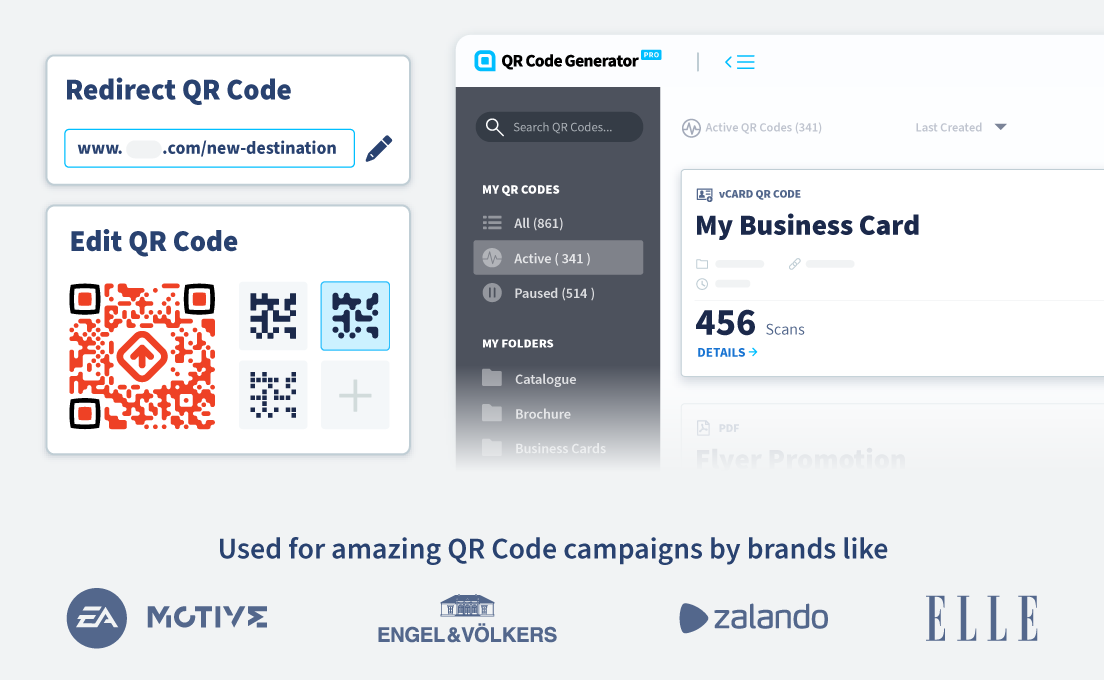- Best Practices ●
- COVID-19 ●
- Industry Trends ●
- Partners ●
- Product ●
Product Marketing With QR Codes: Everything You Need to Know
Every brand wants to improve its sales. Maybe you’ve tried to do it by upping your ad spend, investing in an influencer-led campaign, or embarking on a new brand partnership.
While all these tactics can help boost sales, there’s also a simpler, much more cost-effective strategy you need to consider: embracing QR (Quick Response) Codes for product marketing.
What is product marketing?
Product marketing is the connector between marketing and sales. The idea, of course, is to sell more products and generate a profit. But it also includes points such as:
- Making sure a product’s features have a suitable position in the market.
- Communicating with sales and marketing teams to ensure they have all the knowledge to prepare their strategies.
- Understanding how a product solves a customer’s pain points.
- Adapting the product as customer demand and the market evolve.
- Creating go-to-market strategies for how products will be marketed and sold.
- Formulating buyer personas and the relevant content strategy to appeal to a specific target market.
As opposed to more generic conventional marketing methods, product marketing takes a highly strategic approach and is in itself a part of conventional marketing. While conventional marketing focuses more on the promotion of the brand, product marketing emphasizes the value of the products and how to sell them.
What is the relationship between product marketing and QR Codes?
QR Code technology was originally developed to improve upon Barcodes used for product inventory management. QR Codes hold large amounts and a wide variety of types of information due to their cleverly designed square shape.
While their original use was intended to keep track of products, QR Code technology has made huge advances. They now have countless uses in sales and marketing, as well as just general product enhancement. Let’s take a look at how this works.
With a QR Code, you can turn your product packaging into an enticing customer touchpoint, linking to a landing page for your current marketing campaign.
It’s something that Coca-Cola has been doing for more than a decade. Its first QR Code marketing campaign was in 2012 when the company partnered with the UEFA European Championship.
Coca-Cola embedded QR Codes onto its Coke and Coke Zero cans. When customers scanned the codes, they opened up content like UEFA’s Euro 2012 videos and Coca-Cola SmileWorld, Coca-Cola’s online community.
Explaining the move, Paco Rodriguez, digital manager at Coca-Cola, said, “Thanks to intelligent QR Codes, we are able to constantly surprise our consumers with new content, strengthen our position in the mobile space, and understand what interests our consumers.”
How QR Codes enhance marketing efforts
In the digital-driven landscape, harnessing the power of QR Codes for marketing can be game-changing. These small but mighty symbols are like a portal between the physical and digital worlds, offering an innovative, lightning-fast way to reach and connect with your audience.
Here’s a closer look at how QR Codes can enhance your marketing efforts.
Collect data insights to improve future campaigns
One of the biggest advantages of QR Codes is the ability to uncover crucial insights about your audience.
After all, all successful marketing campaigns rely on data-driven analysis. These insights help you discover and refine your target audience and, more crucially, deliver the right marketing content at the right time.
With a Dynamic URL QR Code by QR Code Generator PRO, you’ll get access to key analytics like the location of a scan by country and city, the operating device (Android or iPhone), the number of unique scans, and the number of scans over time.
Not only does this essential information allow you to compare campaigns across different time periods and locations, but it also allows you to track ROI (return on investment) on print materials.
In the past, it was almost impossible to quantify the returns of posters, billboards, and product packaging, making it difficult to learn what creative ideas worked well and which didn’t.
Thankfully, QR Codes eradicate this issue, enabling you to track exactly how many people showed interest by scanning the code.
Plus, you can elevate QR Code tracking a step further with Google Analytics, the combination of which gives you more granular visibility into customer behavior regarding referral traffic, bounce rate, returning visitors, and more.
Customized QR Code designs to increase brand awareness
Forget nondescript black-and-white QR Code designs. With modern QR Code software, you can completely customize the look and feel of your marketing QR Code.
With custom frames, a range of colors, the option to add your logo, and more, you can turn your QR Code into another emblem of your brand.
For example, if your brand colors are green, pink, and white, you can customize your QR Codes with a matching color palette so they fit in seamlessly with your marketing materials—whether they’re on printed or digital assets. This can help draw customers’ attention and create more interest than a standard black-and-white code.

Pro tip: There are some important factors to take into consideration when adding QR Codes to print materials and product packagings, such as size and graphics. A fantastic overview of this can be found here.
Create versatile assets that are easy to repurpose
As well as offering amazing design potential, Dynamic QR Codes pack a powerful punch because you can place them virtually anywhere and link them to all sorts of online marketing resources.
For example, on your products, you could create QR Codes that take users to your social media pages or product review pages with a Rating QR Code.
Alternatively, on a print ad, you could add a QR Code that transports your audience to the exact product information landing page, where interested consumers can easily purchase your product.
Not only is this kind of marketing a “nice to have,” it’s also crucial for boosting sales. According to PwC research, today’s consumers rank speed and convenience as two of the most important facets of the customer experience—and QR Codes are the ultimate combination of the two.
6 easy ways to use QR Codes in your marketing efforts
1. Business cards
If you market your product at events, trade shows, or pop-up fairs, adding QR Codes to your business cards is an excellent way to accelerate the customer marketing journey.
Instead of having to manually discover your brand on social media or type in your website, QR Codes enable potential customers to seamlessly visit your social profiles and webpages with a single scan.
You can elevate this concept even further with vCards with QR Codes, which give contacts access to your advanced contact details—plus the ability to save your information directly to their phone!
2. Billboards
With QR Codes, you can turn previously static billboard ads into dynamic, digitally-fueled customer interactions. As well as linking to product pages and social media profiles, billboards are also the perfect place to get a little creative. Recently, many brands have used billboards as the basis for QR Code scavenger hunts.
For example, in the run-up to the third series of Netflix’s Love, Death + Robots, the platform launched a digital scavenger hunt for nine QR Codes embedded across social media, billboards, and even the actual show.
By gamifying QR Codes, brands can engage their target audience in exciting, fun ways and capture their attention in an otherwise crowded digital landscape.
3. In-store signage
Another use of QR Codes is to enhance the in-store experience, adding a new level of transparency to the in-store shopping experience. For example, by using QR Codes on in-store signage, you can encourage users to read more about certain products, access coupon codes, or even read real-world reviews.
That’s exactly what Brookstone did in its stores. The company added QR Codes across its floor signage and even on the labels of certain products, helping potential customers effortlessly find out more about products they’re interested in, with the aim of boosting sales.
4. TV commercials
Another static medium QR Codes can transform is TV commercials. Instead of being a one-way street, you can use QR Codes to turn commercials into a dynamic customer interaction.
Take Burger King, which added a QR Code to one of its Burger King Whopper commercials, offering viewers the chance to win a free burger by scanning the QR Code and entering their details.
Not only did this strategy boost customer engagement in the short term, but by tracking the QR Code responses, Burger King was able to discover which codes triggered the most engagement—and when and where—helping the brand to develop more targeted, effective TV campaigns in the long term.
5. Product packaging
As the earlier Coca-Cola example shows, placing QR Codes on product packaging is a great way to intrigue your customers, start a dialogue, and boost the chances of them building an affinity with your brand.
For e-commerce brands, in particular, product packaging is a fantastic way to elevate brand awareness. For example, you could step up your product packaging game by adding a Video QR Code, enabling customers to understand more about your brand values or upcoming products.
Plus, with the shift towards retail sustainability, using a QR Code to foster transparency about your materials is a great way to energize customer loyalty.
After all, McKinsey research shows that young shoppers want to buy from brands with strong sustainability credentials. So, why not highlight your sustainability creds through a QR Code?
Alternatively, if you’re in the food business, adding QR Codes to your product packaging can increase transparency in a different way: by showcasing nutritional information.
As more consumers think about the quality and nutritional value of the food they eat, proactively highlighting the nutritional content of food products shows your customers that you’re keen to help them live a healthy lifestyle.
That’s what McDonald’s did back in 2013, adding QR Codes to its food packaging to help customers quickly find the calorie content of the food they’d purchased.
6. Social media
Nowadays, retailers rely heavily on social media for brand awareness and promoting their products—and QR Codes are a fantastic mechanism for upping your followers.
Because they’re so small, customizable, and versatile, you can easily add Social Media QR Codes to tags, shopping bags, and other packaging materials—both when purchased online and in-store.
Creative QR Code marketing examples
Ready to elevate your marketing strategy with QR Codes? Let’s look at a few real-world QR Code marketing examples to inspire you.
Coca-Cola transforms QR Codes into art
Coca-Cola has been a trailblazer in the QR Code game for a while, and its campaigns keep on getting better and better. For example, in 2023, Coca-Cola launched innovative, illustrative QR Codes for its Coke Studio music platform.
Not at all like the black-and-white QR Codes we’re all familiar with, the company placed these beautifully designed QR Codes in theaters, theme parks, and more.
When users scanned them, it transported them to a clip from a music video for a song created by Coke Studios.
The QR Code campaign did wonders for boosting awareness about Coke’s music venture—and the song highlighted in the QR Code now has over 10 million streams on YouTube.
Roku and Barbie display QR Codes on home TVs
As part of its global marketing campaign to boost cinema sales for the Barbie movie, Warner Bros and Mattel teamed up with Roku to encourage viewers to purchase cinema tickets at home.
How? Through a QR Code, of course. When Roku users went to their TV screen homepage, they saw a Barbie banner highlighting the upcoming movie. When they clicked the banner, viewers then saw a trailer for the movie next to a QR Code.
When scanned, the QR Code took users to a page where they could purchase cinema tickets for a local movie theater.
Beazley flies drones in QR Code formation
Another creative example of QR Code product marketing comes from Beazley, an insurer that showcased its brand refresh by lighting up the skies of London with a swarm of drones that formed a huge QR Code image.
When people scanned the QR Code, it took them to Beazley’s revamped website, where they could discover more about the company’s brand re-launch and services.
QR Code best practices
To set up your QR Code product marketing for success, there are a few best practices to keep in mind to ensure your efforts have maximum impact.
- The size of your QR Code will vary greatly depending on the communication medium you’re using. So, be sure to use the correct size for the distance-to-scanning ratio in question, and always be sure to use at least the minimum required QR Code size.
- Always add a call to action (CTA) to your QR Codes to nudge customers to take action. Whether you’re encouraging them to sign up for a newsletter, set up an appointment, or buy a product, make sure your CTA is clear and compelling.
- Remember that your QR Codes are an extension of your brand. Be sure to add your brand colors, logo, and any visuals to boost brand awareness and recognition.
- QR Codes are best used strategically: Don’t just place them anywhere and everywhere. For example, placing more than one code on a single asset can be cluttered or confusing—especially if the QR Codes have multiple functions!
- Before launch, always test the code (and then test it again) to make sure everything works as it should.
Add a user-friendly QR Code generator to your marketing tool kit
QR Codes are a surefire way to reach new customers and build enhanced loyalty with your current ones. While these tech-driven symbols might seem complex to create, a streamlined tool like QR Code Generator PRO has simplified QR Code design and creation.
We specifically designed our intuitive, easy-to-use QR Code generator to help marketers like you unlock the potential of QR Codes for your marketing efforts. You can effortlessly bring your creative QR Code ideas to life with plenty of customization options and features.
Sign up for QR Code Generator PRO today and take your product marketing campaigns to the next level.






 Add custom colors, logos and frames.
Add custom colors, logos and frames.
